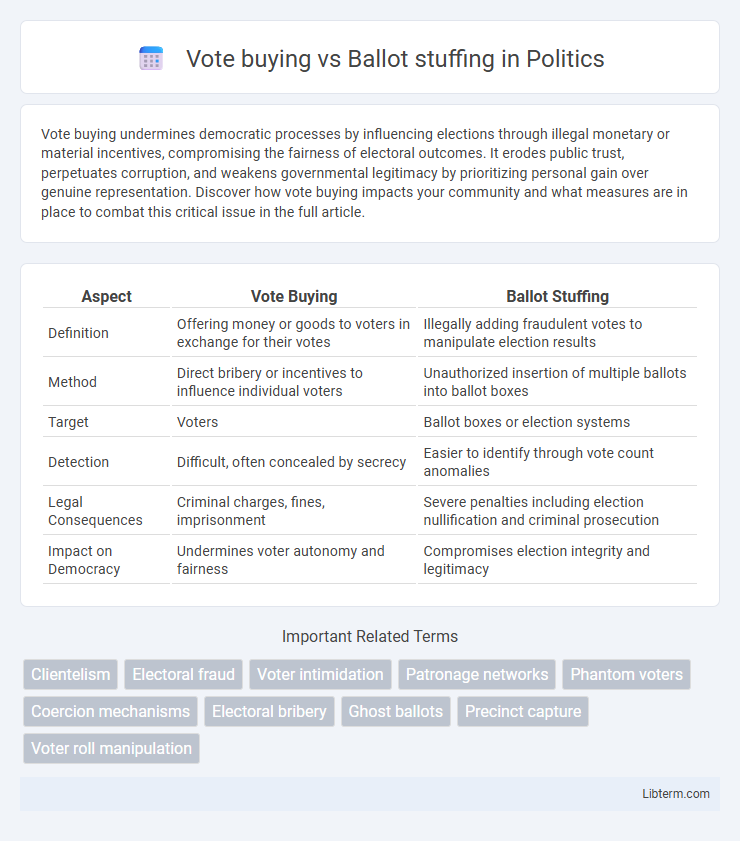Vote buying undermines democratic processes by influencing elections through illegal monetary or material incentives, compromising the fairness of electoral outcomes. It erodes public trust, perpetuates corruption, and weakens governmental legitimacy by prioritizing personal gain over genuine representation. Discover how vote buying impacts your community and what measures are in place to combat this critical issue in the full article.
Table of Comparison
| Aspect | Vote Buying | Ballot Stuffing |
|---|---|---|
| Definition | Offering money or goods to voters in exchange for their votes | Illegally adding fraudulent votes to manipulate election results |
| Method | Direct bribery or incentives to influence individual voters | Unauthorized insertion of multiple ballots into ballot boxes |
| Target | Voters | Ballot boxes or election systems |
| Detection | Difficult, often concealed by secrecy | Easier to identify through vote count anomalies |
| Legal Consequences | Criminal charges, fines, imprisonment | Severe penalties including election nullification and criminal prosecution |
| Impact on Democracy | Undermines voter autonomy and fairness | Compromises election integrity and legitimacy |
Understanding Vote Buying and Ballot Stuffing
Vote buying involves offering money or goods to voters in exchange for their support, undermining the democratic process by compromising free choice. Ballot stuffing refers to casting fraudulent votes by submitting multiple ballots, artificially inflating vote counts to sway election results. Both practices distort electoral integrity and erode public trust in the legitimacy of election outcomes.
Historical Context of Electoral Fraud
Vote buying dates back to ancient Rome, where patrons offered gifts or money in exchange for political support, highlighting the early manipulation of voter behavior. Ballot stuffing emerged prominently during the 19th and early 20th centuries, particularly in the United States and Russia, as a method to inflate vote counts and undermine election integrity. Both practices reflect historical challenges in maintaining free and fair elections, underscoring the evolution of electoral fraud countermeasures over time.
How Vote Buying Works
Vote buying involves offering money, goods, or services to voters in exchange for their support during elections, directly influencing voter behavior. This practice manipulates the democratic process by targeting individual voters with incentives, disrupting free and fair elections. Ballot stuffing, in contrast, entails illegal manipulation of votes through adding fraudulent ballots, typically performed by election officials or party agents rather than voters themselves.
Mechanisms Behind Ballot Stuffing
Ballot stuffing involves the illegal addition of votes into the ballot box, often orchestrated by election officials or party agents to inflate vote counts for a favored candidate. This mechanism bypasses the voter's consent, contrasting with vote buying where the voter is bribed to cast a ballot in a specific way. Ballot stuffing typically requires collusion, manipulation of polling station procedures, and exploitation of weak electoral monitoring systems to add fraudulent votes undetected.
Key Differences Between Vote Buying and Ballot Stuffing
Vote buying involves offering money or goods to influence voters to cast their ballots for a particular candidate, targeting individual voter behavior. Ballot stuffing refers to the illegal practice of submitting multiple votes or fake ballots to artificially inflate vote counts in favor of a candidate or party. The key difference lies in vote buying manipulating voter choice legally exercised, while ballot stuffing directly compromises the integrity of the vote tallying process.
Motives and Incentives for Electoral Manipulation
Vote buying involves offering money or goods to voters to secure their support, driven by politicians' motives to influence election outcomes and maintain power through immediate voter loyalty. Ballot stuffing entails fraudulently adding votes to inflate actual voter turnout or candidate support, motivated by desires to fabricate legitimacy and manipulate results in tightly contested races. Both practices serve as incentives for electoral manipulation by undermining democratic processes and guaranteeing success for favored candidates or parties.
Impact on Democracy and Election Integrity
Vote buying undermines democracy by eroding voter autonomy, compelling individuals to sell their votes for financial gain, which skews electoral outcomes and weakens public trust in political systems. Ballot stuffing compromises election integrity through the artificial inflation of vote counts, enabling fraudulent manipulation that distorts voter representation and delegitimizes election results. Both practices contribute to systemic corruption, diminish the legitimacy of elected officials, and hinder the effective functioning of democratic institutions.
Detecting and Preventing Vote Buying
Detecting vote buying involves monitoring suspicious financial transactions, analyzing voter behavior patterns, and employing whistleblower reports to identify illicit incentives offered to voters. Preventing vote buying requires strict enforcement of campaign finance laws, voter education programs highlighting the legal consequences, and deploying independent election observers to ensure transparency during the voting process. Advanced data analytics and cross-referencing voter rolls with incident reports also enhance detection efforts against vote buying practices.
Identifying and Combating Ballot Stuffing
Ballot stuffing, a form of electoral fraud, involves illicitly adding multiple votes to manipulate election outcomes, distinguished from vote buying, which entails purchasing votes from individuals. Identifying ballot stuffing requires monitoring for abnormal vote surges, discrepancies in voter turnout, and irregularities in ballot box seals or counts during audits. Combating ballot stuffing demands robust election monitoring, transparent vote counting procedures, use of tamper-evident ballot boxes, and legal enforcement against perpetrators to uphold electoral integrity.
Case Studies: Real-World Examples of Electoral Fraud
Vote buying, a corrupt practice where voters receive money or goods in exchange for their votes, has been extensively documented in countries like Nigeria and the Philippines, undermining electoral integrity and skewing election results. Ballot stuffing, involving the illegal addition of ballots to inflate vote counts, has been notably reported in Russia and Zimbabwe, directly manipulating election outcomes through fraudulent vote totals. These case studies highlight the diverse methods of electoral fraud and the urgent need for robust monitoring and enforcement mechanisms to safeguard democratic processes.
Vote buying Infographic

 libterm.com
libterm.com